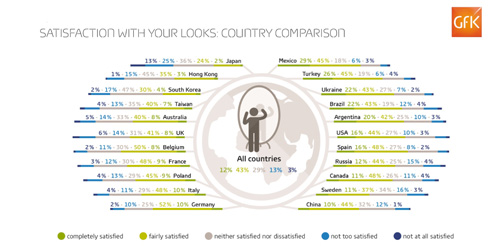Last week SPA+CLINIC investigated the rise of body dysmporphia, and how medical and health professionals are becoming increasingly alert to identifying this distressing condition in patients and clients and ensuring they seek appropriate treatment to deter them from pursuing self-destructive ‘solutions’.
 But here’s some encouraging news … over half of people internationally are fairly satisfied or completely satisfied with their looks according to new research by GfK*, with 12 percent going as far as to say that they are ‘completely satisfied’.
But here’s some encouraging news … over half of people internationally are fairly satisfied or completely satisfied with their looks according to new research by GfK*, with 12 percent going as far as to say that they are ‘completely satisfied’.
In contrast, only 16 percent claimed any dissatisfaction with how they look, including three percent who state that they are not at all satisfied. The remaining 29 percent are neutral.
The survey also found that teenagers are only slightly more likely to be dissatisfied than older age groups and the Japanese are the most self-critical, with more than one in 10 ‘not at all satisfied’ with their appearance.
Complete satisfaction with personal looks is highest in Latin America, with Mexico, Brazil and Argentina all appearing in the top five for the percentage of population claiming this.
When GfK widened this to include those who say they are fairly satisfied, as well as those who are completely satisfied, Mexico remains on top, standing at 74 percent, closely followed by Turkey at 71 percent.
Brazilians and Ukrainians come next at 65 percent each, then the Spanish at 64 percent, with Germans and Argentinians tying at 62 percent, followed by the British at 20 percent, then Russians, South Koreans, Swedes and we Australians all at 19 percent.
These findings are key for businesses in the fashion, beauty and personal grooming sectors in identifying how messaging can be refined to resonate more strongly with specific markets or target groups.
In countries like Japan, the UK and Russia, significant numbers will respond to marketing based around ‘improve or change your look’, while consumers in Mexico and Turkey are more likely to respond to offers around ‘refine and maintain your look’.
Overall, 16 percent of 15-19 year olds say they are ‘not too satisfied’ with their looks, compared to 12-13 percent for the age groups between 20 and 59 years old.
People aged 60 and over proved to be the least self-critical, with just nine percent being not too satisfied with their looks and three percent not at all satisfied.
Comparison of the male and female responses also shed new light on the assumption that women are more critical of their looks than men.
Both genders run equal in the percentage that are happy with their looks – each standing at 43 percent, saying they are fairly satisfied and 12 percent completely satisfied.
 However, men are more likely to be neutral about this question than women (31 percent versus 27 percent). When it comes to being dissatisfied with their looks, women creep ahead of the men, but only by a few points – 14 percent being not too satisfied, compared to 11 percent of men, and four percent being not at all satisfied, compared to three percent of men.
However, men are more likely to be neutral about this question than women (31 percent versus 27 percent). When it comes to being dissatisfied with their looks, women creep ahead of the men, but only by a few points – 14 percent being not too satisfied, compared to 11 percent of men, and four percent being not at all satisfied, compared to three percent of men.
So what’s the secret of the 55 percent of people worlwide who are reasonably-to-completely satisfied with their looks?
There is no doubt that overall state of mind plays a huge role. Someone who is unhappy within themselves will often focus – even obsess – negatively on one aspect of their lives, such as their looks.
They may even blame their looks for their unhappiness, constantly analysing and agonising about what is looking back from the mirror, an worrying about what others think of their appearance.
Using research from 100 world experts on the psychology of happiness, in 2012 author Leo Bormans published The World Book Of Happiness. He was determined to profile the qualities that contributed to greater happiness in and satisfaction with life (ergo, looks). Among his findings:
ACCEPT WHAT YOU HAVE
Research shows that happy people have modest levels of expectation and aspirations – they want what they can get – while unhappy people never seem to get what they want. They also know how to avoid disappointments and how to generate pleasant surprises. This is because they strive for realistic goals and are happy with their lot. As Dr Jose de Jesus Garcia Vega, of the University of Monterrey, Mexico, confirms: ‘We spend a lot of time complaining about the things that happen to us, but this is a waste of time and effort. To be happy, we need to enjoy what we have.’
ENJOY WHAT YOU DO
Happy people do what they enjoy and enjoy what they do – and don’t do it for the money or glory. There’s no point being stuck in a job you hate, surrounded by unfriendly colleagues just because the money is good. People forget that they are allowed to be happy at work, too. Many spend the best years of their lives trying to make money, sacrificing their health and family in the process, says Dr Vega. Later, they spend the same money they made working trying to recover their lost health and estranged family.
LIVE FOR TODAY
Don’t dwell on the past, on things that went wrong or previous failures. Similarly, don’t dream about an idealised future that doesn’t exist or worry about what hasn’t happened yet. Happy people live for the now; they have positive mindsets. If you can’t be happy today, what makes you think tomorrow will be different?
CHOOSE HAPPINESS
Don’t be afraid to step back and re-evaluate your goals. Imagine your life as a story that you can edit and revise as you go along. This kind of flexible approach requires positive thinking and an open mind. You need to actively choose to be happy.
IT’S VOLUNTARY
‘You always have the freedom to choose the manner in which you wish to approach any given situation,’ says Dr Vega. This theory is backed up by Ingrida Geciene of Vilnius University, Lithuania, who researched the happiness of people in 31 European countries.
She found that ‘voluntarists’ (people who feel they have free choice and complete control over their life) were happier than ‘fatalists’ (people who think little can be changed by personal intervention).
Just for the record, surveys have shown that Iceland has the happiest population on Earth. Notherrn European countries contain more voluntarists while Latin European countries such as Spain and Italy have a higher percentage of fatalists.
RELATIONSHIPS
We get much of our happiness from other people, and from supporting other people. Remember that just as other people can make us happy, we are all ‘other people’ to someone else. So cherish people who are important to you.
STAY BUSY
If you want to be happier, develop an outgoing, social personality – accept that coffee invitation, join the walking club, book group or choir. The best way to savour pleasure is in the company of others. Build a rich social life, says Eunkook M. Suh, a psychology professor at Yonsei University in Seoul, South Korea, not as an obligation, but because it is rewarding, meaningful and fun.
Active, busy, social people are the healthiest and happiest, in society. Get involved: make your motto ‘use it or lose it’.
DON’T COMPARE
Ambition is healthy and makes people happy, explains Claudia Senik, a professor at the University of Paris-Sorbonne, but envy makes them unhappy. Yet comparisons with others can spoil the benefits of ambition and are only useful if you learn something from them. Focus on your goals and dreams so you can enjoy your ambition and achievements.
BE YOURSELF
Just as you shouldn’t compare yourself with others, it’s important not to worry about what others think about you – then you can truly be yourself.
Happy people are spontaneous, natural and real; they say what they think and feel, and aren’t concerned what others think of them. Being oneself makes one feel free and authentic.
STOP WORRYING
Don’t take yourself too seriously. Happy people don’t worry and they recognise that 90 per cent of worries never come true.
GET ORGANISED
You might envy those laid-back bohemian types who just do things on the spur of the moment, but don’t be fooled. Happy people plan and organise, they have goals and a purpose. You can only get what you want or desire if you know what it is you want or desire in the first place. So while those chilled-out friends might seem happy, they’re actually just drifting along.
THINK POSITIVELY
Bottling up emotions and bad feelings creates psychological distress and physical discomfort. Happy people get things off their chest, their motto is: get rid of it, or it will get rid of you. Similarly, work at developing optimistic thinking; happy people always look on the bright side.
Successful athletes know to focus on winning, not losing, explains Miriam Akhtar, one of the first positive psychologists in the UK. We need to switch from a negative, glass-half-empty outlook to a glass-half-full and put optimism into practice to be happiest. Optimism is the mind’s natural self-defence mechanism against depression.
VALUE HAPPINESS
Happiness can be learned, but finding meaning and a purpose in life is what leads to it, not the other way around. The happiest people appreciate and realise that being happy adds years to their life, and life to their years.
* GfK is the trusted source of relevant market and consumer information that enables its clients to make smarter decisions. More than 13,000 market research experts combine their passion with GfK’s long-standing data science experience. This allows GfK to deliver vital global insights matched with local market intelligence from more than 100 countries. By using innovative technologies and data sciences, GfK turns big data into smart data, enabling its clients to improve their competitive edge and enrich consumers’ experiences and choices. www.gfk.com/au




